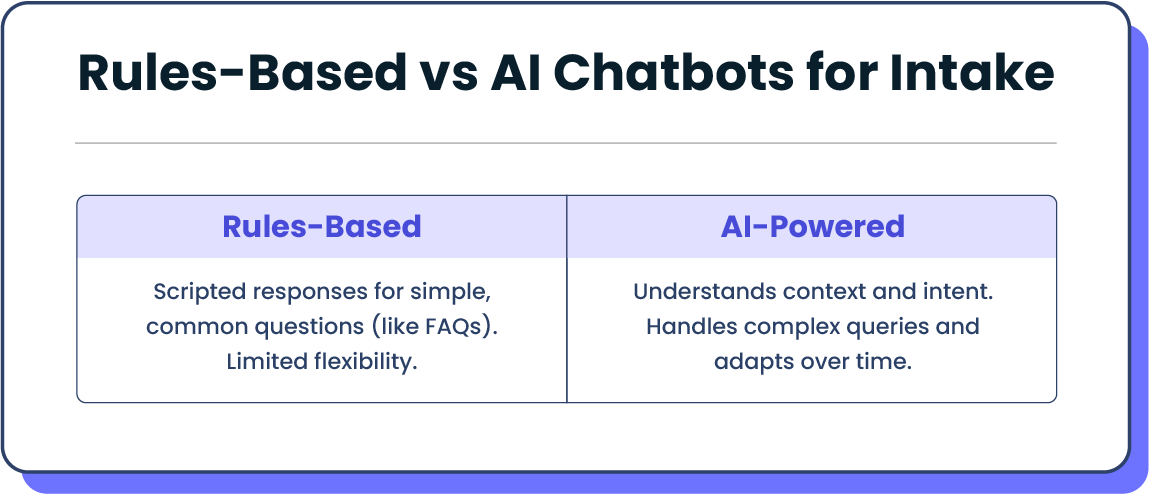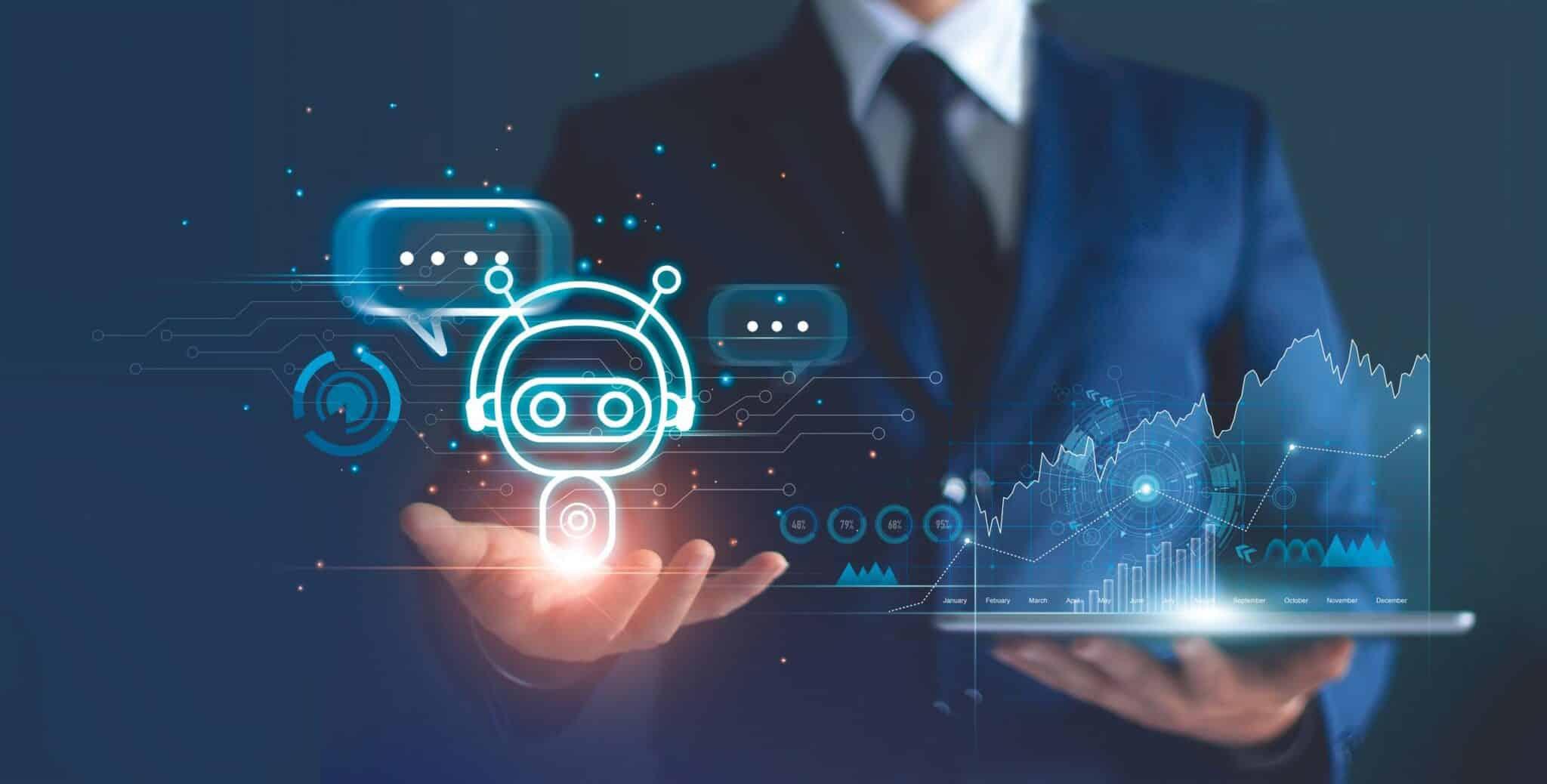If you’ve been following technology news, you’ve heard about the exponential leaps in artificial intelligence (AI). AI is becoming increasingly integrated into our daily lives, from virtual assistants managing our schedules to recommendation algorithms curating what we watch or buy.
Advances in AI are also creating buzz across many industries to empower professionals with tools that help them work smarter and faster. This is especially true in the legal industry, where legal AI chatbots are gaining momentum in order to improve client experiences and legal workflows.
However, like all new technology, AI has its strengths and weaknesses. In this article, we’ll give you an overview of what legal chatbots are, how they’re being used, and what to consider if you plan to implement a chatbot for your law firm.
What Is a Legal AI Chatbot?
Legal AI chatbots are software tools that leverage artificial intelligence, including natural language processing, machine learning, and generative AI, to simulate human-like conversations and assist with legal tasks. These chatbots use generative AI to draft documents, answer legal questions, and streamline client communications by generating context-aware, conversational responses.
Generally, people interface with these chatbots using a simple text-based interface. There are also public AI tools like ChatGPT, as well as chatbots that are specifically tailored for use in legal software.
Rules-Based vs AI Chatbots for Intake
Many of us have seen chatbots pop up at the bottom of websites asking if we have questions. What’s the difference between a rules-based chatbot and an AI-powered chatbot?
Rule-based chatbots operate using decision trees and scripted responses. They follow predefined rules and respond only to specific prompts (e.g., “What are your hours?”). These bots are best for FAQs and predictable workflows but lack flexibility.
AI-powered chatbots, on the other hand, use natural language processing (NLP) and machine learning to understand context, intent, and nuance. They can engage in more dynamic conversations, handle a wider range of inputs, and improve over time based on interactions. These bots can personalize responses and handle more complex legal queries (within ethical limits).

In general, rule-based chatbots are easier to implement and pose less ethical risks because their answers are predefined. However, they lack personalization and have a limited number of uses.
Used ethically and powered by legally-compliant systems, AI chatbots can help law firms create a client-focused experience by providing faster, more personalized responses.
Will Legal Chatbots Replace Lawyers?
As automation and AI gain steam in the business world, one question that comes up repeatedly is whether these technologies will replace lawyers and paralegals entirely.
The short answer is no. Generative AI chatbots, while extremely helpful for certain tasks, are no replacement for human expertise and nuance. Instead, AI tools can help lawyers do their jobs better by streamlining simple tasks, communication, and summaries.
There are also ethical considerations that must be examined when using chatbots in a legal setting. Lawyers have to ensure that the output from legal chatbots is:
Secure: If chatbots are accessing sensitive client information, they must adhere to strict security standards to protect client data.
Accurate: Chatbots can sometimes “hallucinate”, creating coherent-sounding but not fully accurate responses. Lawyers must proofread any responses generated by AI for accuracy.
Unbiased: Unlike a trained lawyer or paralegal, a chatbot needs to treat all data equally, even if that information comes from biased or outdated sources.
Types of Legal AI Chatbots and Their Use Cases
While it’s easy for many of us to imagine chatbots being used for simple searches or in retail businesses, lawyers may struggle to see how this technology could be applied in the legal world.
In an industry that’s so much more complex and full of ethical landmines, legal AI chatbots tend to be designed for more specialized use cases. However, as technology continues to upend client expectations, AI has been invaluable for enhancing client intake, automating timekeeping, and improving other traditionally admin-heavy tasks. As a result, lawyers can spend more time on creating better client experiences.
Below are the primary areas where legal AI chatbots are currently used.
Website-Based Intake AI Chatbots
Client intake is a crucial part of starting a legal matter off on the right foot, but having a human on the other end of a chat window or phone line uses a lot of time and resources—or leads that aren’t a good fit.
Chatbots for law firms can live on legal websites in order to greet visitors and ask questions to see if a person is just browsing or is a potential lead. Since the chatbot provides live responses 24/7, it can rapidly boost conversion rates compared to human chat.
As the legal chatbot works through a prospect’s information, it can also sync with client relationship management (CRM) software, so all information is captured and lawyers’ calendars can be consulted for scheduling follow-ups.
As a result, client intake and lead management are a great use for AI in the legal industry, as it can free up legal assistants and paralegals to focus on more strategic work or focus on clients who have more detailed questions. Currently, MyCase integrates with Smith.AI and Intaker to enable law firms to provide 24/7, multilingual client intake services.
Client Communication AI Chatbots
Clear and timely client communication is crucial for securing client prospects and delivering an overall smooth experience from the start.
This is another area where chatbots for lawyers can help. Chatbots powered by generative AI can help draft responses to common questions. For example, services like Kenect can sync with your case management software to send personalized text messages to clients and leads directly from your phone number.
It’s also worth noting that AI is not the best fit for every type of communication, similar to automated messages. But when used correctly, it can increase response time and client satisfaction.
Document Drafting AI Chatbots
One of the most time-consuming tasks for an attorney is the process of drafting documents, contracts, and pleadings. AI, such as ChatGPT and legal AI software, is capable of creating first drafts for complex legal documents in a fraction of the time, especially if it’s drawing from existing documents.
Lawyers using AI chatbots can also streamline document tasks like:
Drafting content
Document summary
Ideating or rewriting client communication to meet different tones
Brainstorming for cross-examination or voir dire
Creating marketing and social media copy
Reviewing or drafting website copy that is optimized for law firm SEO
However, these tools are public, meaning they must be used extremely carefully to maintain ethical compliance. Therefore, if you’re interested in using these tools to more securely streamline your content creation, use paid versions that allow you to turn off AI model training in the settings.
AI can also help create templates and impersonal drafts, but should not be used to construct anything involving specific client or case information. Any documents or information you feed into a public AI tool should be scrubbed for confidential data.
Legal-specific AI tools can also assist with research and citation checks by looking through legal resource libraries to help with document accuracy. However, even when AI is using your documents as a reference, always review any AI-generated document to ensure accuracy and compliance.
AI Legal Billing & Time Tracking
Time tracking and creating summaries of billable work can take up time, and are prone to error when done manually.
Tools like Billables AI eliminate the need for manual timers and data entry by passively capturing a lawyer’s work activity between all of the apps they’re using, then generating detailed summaries for time entries. Solutions like MyCase integrate with these types of AI tools to help attorneys capture the most billable time while efficiently managing cases on one platform.
Benefits of Legal AI Chatbots for Law Firms
Implemented correctly and with ethical boundaries, AI has the potential to support law firms through streamlined workflows and faster communications.
Chatbots can help law firms lighten the daily admin load by answering general questions and capturing client intake. Legal chatbots can also integrate with legal technology to perform specific tasks, ensuring you know exactly how AI is being used in your law firm.
Below are a few of the benefits of using AI in your law firm.
Save Time on Repetitive Tasks
Some experts estimate that most attorneys spend just 30% of their day on billable hours. Where does the rest of the time go? Usually into administrative work and other repetitive tasks, such as scheduling, billing, and marketing.
AI can act as a virtual legal assistant, helping reclaim lawyers’ time by streamlining common administrative tasks, such as:
Scheduling: Sync AI bots with scheduling to automatically set up meetings with existing and potential clients.
Billing: Instead of manually writing out bills, use AI tools to generate invoices and follow up on billing notices.
Reminders: Set up an AI to handle simple communication follow-ups or reminders about upcoming meetings, document deadlines, or court appointments.
Intake forms: Enable faster client intake by filling client intake forms based on the answers potential clients give to an AI chatbot, then populating that information into CRM systems.
Text editing: Use AI to check client communications for errors, tone of voice, and remove any legal jargon.
Improve Client Satisfaction and Responsiveness
The legal world is complex and intimidating for many clients, which naturally leads to them having many questions. Typically, the type of information clients need is relatively simple, and doesn’t necessarily need a lawyer or paralegal to answer—and yet, without an alternative way to communicate, clients are left waiting.
AI chatbots can significantly improve response times for simple queries, helping boost client satisfaction and creating a more engaged experience overall. As multilingual support gets more ubiquitous, you can also provide the same information to non-native speakers.
Automated reminders and other helpful messages also reduce the chance of miscommunication or errors.
Boost Conversion Rates and Case Volume
Client lead generation and marketing are essential for law firm growth, but not every law firm has the resources for a dedicated marketing or intake team.
While generative AI doesn’t replace the need for a well-crafted intake process, it can assist by handling the basic administration, data entry, and initial communication. This will not only ensure that prospects feel engaged and productive during the early steps, but also ensure that when you do speak with them, you can maximize the time by talking about the issues that matter to them most.
AI can also be used to automate lead generation workflows, following up with prospects who entered their information over SMS or email to schedule a consultation or point them towards helpful resources that are personalized to them.
How to Implement Legal AI Chatbots
Since generative AI uses plain language prompts, it makes it accessible to people of all technical abilities.
Chatbots are generally easy to integrate into your firm’s website and are available as a custom build or a software-as-a-service (SaaS) platform. If you hire a developer to design a custom chatbot, it functions exactly as you want, but it typically costs more money and time.
On the other hand, legal chatbots from SaaS services are usually ready-to-use, affordable, and paid in monthly installments. They typically feature full support for installation, training, and may integrate with existing case management software.
Below are ways your firm can integrate a legal AI chatbot into client communication and legal workflows:
Define your goal and use case(s): AI chatbots are not one-size-fits-all solutions. Start by identifying which areas would most benefit from AI help (e.g., client intake, payments and billing, research and case preparation, etc.).
Choose a chatbot that integrates with your existing tech stack: The goal of AI is to streamline your work, not make it more complicated. Prioritize solutions that integrate with your existing case management systems to avoid creating siloed technology that doesn’t communicate with one another.
Customize the chatbot to reflect your firm’s voice: Modern chatbots are sophisticated enough to adopt different personas and tones of voice to match different needs. Tailor greeting messages, intake questions, and follow-up workflows to match your firm’s style.
Test internally and launch gradually: A slip-up using AI could damage your firm’s reputation. So, before you set any chatbots live, run through real-world scenarios with your staff in a test environment to catch any potential issues before they arise.
Train your team and monitor results: Ensure all staff know when and how to intervene.
If you’re unsure about where to start, Nicole Black, MyCase’s Principal Legal Insight Strategist, recommends starting your AI journey with simple, front-of-office tasks. In a recent article she wrote for the ABA, she notes, “Outsourcing reception and intake is one of the easiest and most impactful ways to improve the client experience and streamline operations.”
An important note: Many existing legal technology companies, including MyCase, are already incorporating legal-specific AI tools into their solutions. So, before you invest in a 3rd party AI solution, check with your technology providers on their current AI capabilities to avoid paying for additional services you don’t need.
What’s Next for Legal AI Chatbots
AI is constantly evolving every year. What does this mean for the legal industry? If other industries are any indication, we could see advances in areas like:
Voice assistance: AI-generated voices are getting increasingly convincing, opening up opportunities for people to get legal chatbot assistance over the phone or via voice chat.
Advanced analytics: AI is already excellent at summarizing huge datasets and finding correlations, creating opportunities to leverage legal AI assistants for advanced forecasting, firm performance analysis, and predictions of case outcomes.
Legal research: While a few tools already exist for legal research, it’s getting more sophisticated, potentially supercharging how firms prepare for cases.
Better multilingual support: While translation services already exist in AI, their ability to translate nuanced communication is improving.
Maximize Productivity: Use MyCase With Legal AI Chatbots
Legal AI tools are providing law firms of all sizes with exciting opportunities to streamline mundane tasks so they can focus more on their clients. However, if not implemented carefully or with legal use cases in mind, AI can open up your firm to more risk.
MyCase’s leading legal case management software is carefully integrating with innovative AI tools like Intaker and Smith.AI, which give lawyers the specialized tools they need to succeed.
Explore the right AI tools for your firm by signing up for your free Mycase trial or walk through your needs with one of your experts by scheduling a demo today.
About the author

Adrian AguileraSenior Content Writer
Adrian Aguilera is a Senior Content Writer and SEO Strategist for leading legal software companies, including MyCase, Docketwise, and CASEpeer, as well as LawPay, the #1 legal payment processor. He covers emerging legal technology, financial wellness for law firms, the latest industry trends, and more.
